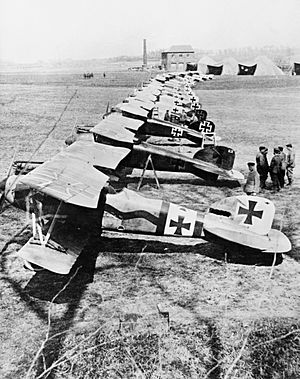Bloody April facts for kids
Quick facts for kids Bloody April |
|||||||
|---|---|---|---|---|---|---|---|
| Part of the Battle of Arras | |||||||
 Albatros D.III fighters of Jasta 11. The second aircraft from the camera (with the step ladder) was painted red, and was one of several flown by Manfred von Richthofen, the most successful ace of the entire war. |
|||||||
|
|||||||
| Belligerents | |||||||
| Commanders and leaders | |||||||
| Strength | |||||||
| Casualties and losses | |||||||
| 245 aircraft 400 aircrew (207 killed) |
66 aircraft | ||||||
Bloody April was a very tough time for British pilots during World War I. It happened in April 1917 during the Battle of Arras in France. The British air force, called the Royal Flying Corps (RFC), was helping the army on the ground.
However, they faced the German air force, the Luftstreitkräfte. The German planes and pilots were often better. This led to many British planes being shot down. The RFC lost nearly four times as many planes as the Germans. This period was so difficult that it became known as "Bloody April."
Why Was April So Bloody?
The Battle of Arras Begins
In April 1917, the British Army started a big attack near Arras, France. This attack was part of a larger plan with the French army. The Royal Flying Corps (RFC) was there to support the British soldiers. Their jobs included flying over enemy lines. They also took photos, watched for enemy movements, and bombed targets.
British Air Strategy and Challenges
The RFC's leader, Hugh Trenchard, believed in attacking the enemy from the air. He wanted his planes to fly over German territory. Many planes were gathered for this purpose in spring 1917. But most of these planes were not as good as the German fighter planes.
Pilot Training Differences
British pilot training was also a big problem. It was rushed and not well organized. New pilots often went to the front lines without enough practice. This was because the RFC needed to replace pilots quickly. Many pilots were lost in battle.
German pilot training was much better at this time. They had learned from earlier losses in 1916. The German air force had been reorganized. They now had special fighter units called Jastas. These units were led by very skilled pilots. They flew new, powerful fighter planes. These planes had two machine guns.
German Air Tactics
The German air force also used smart tactics. They mostly flew over their own territory. This meant their pilots were less likely to be captured. It also meant they could stay in the air longer. They could choose when and how to fight. This helped them win many air battles.
What Happened During the Battle?
Air Forces Gather
The Battle of Arras started on April 9, 1917. The British army had strong air support. The RFC sent 25 squadrons, with 365 aircraft. About a third of these were fighter planes. The Germans had fewer planes at first. They had about five fighter squadrons. This grew to eight squadrons later. They had around 80 fighter planes in total.
Aircraft Strengths and Weaknesses
Since late 1916, the Germans had better planes. Their Albatros D.II and D.III fighters were very strong. They had two machine guns. These planes were better than most British fighters. The British had older planes like the B.E.2c and F.E.2b. These were slow and easy targets.
Some British planes, like the Airco DH.2, were also outdated. Only a few British planes could match the Albatros. These included the SPAD S.VII and Sopwith Triplane. But there were not many of them. Most Allied planes had only one machine gun.
New Planes and Early Losses
New British fighters were not ready yet. The S.E.5 was just starting to be used. It had two machine guns. The Bristol F2A also arrived in April. But it suffered heavy losses on its first flight. Four out of six were shot down by German planes. These German planes were led by Manfred von Richthofen, the famous Red Baron. Even newer British planes like the R.E.8 had many losses at first.
Heavy Casualties
During April 1917, the British lost 245 aircraft. About 400 aircrew were killed, missing, or captured. The German air force lost only 66 aircraft. To compare, the British lost 576 aircrew in five months during the Battle of the Somme in 1916. The Red Baron's squadron alone shot down 89 British planes in April. This was over a third of all British losses.
RFC's Continued Support
Despite these heavy losses, the RFC kept doing its job. They continued to help the army. They provided important photos and information. They also helped guide artillery fire. This support was very valuable to the British army. The German fighter squadrons mostly stayed behind their own lines. This meant they had "air superiority" (they were better in the air). But they did not have "air supremacy" (full control of the sky). The RFC could still fly and support the ground troops.
What Happened Next?
New Aircraft Arrive
After Bloody April, things started to change. Within a few months, new and better British fighter planes arrived. These included the SE.5, Sopwith Camel, and SPAD S.XIII. These planes were much more advanced. They quickly started to win against the German Jastas.
Improved Training and Tactics
The RFC learned from its mistakes. They improved pilot training and how they organized their flights. By mid-1917, more new and better aircraft were at the front. By late summer 1917, the British had much better control of the skies.
The air battles for the rest of the war were never as one-sided again. Bloody April was the last time the Germans truly had a big advantage in the air. While air control changed hands sometimes, the British and their allies generally had the upper hand after this period.

